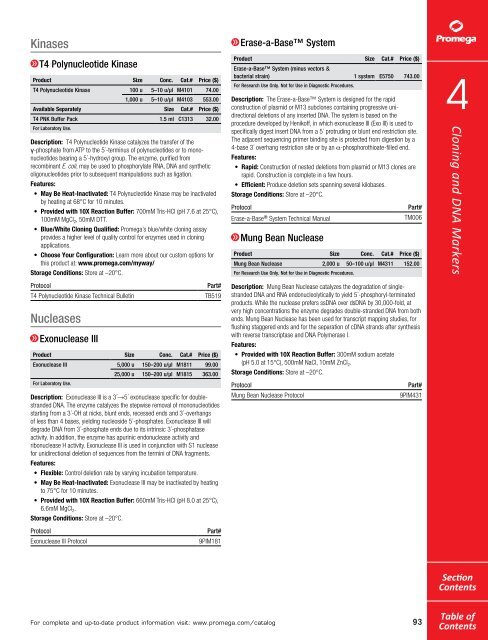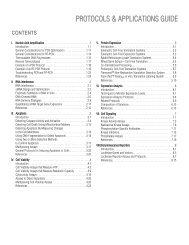2012 Promega catalogue
2012 Promega catalogue
2012 Promega catalogue
You also want an ePaper? Increase the reach of your titles
YUMPU automatically turns print PDFs into web optimized ePapers that Google loves.
Cell Signaling<br />
Kinases<br />
T4 Polynucleotide Kinase<br />
Product Size Conc. Cat.# Price ($)<br />
T4 Polynucleotide Kinase 100 u 5–10 u/µl M4101 74.00<br />
1,000 u 5–10 u/µl M4103 553.00<br />
Available Separately Size Cat.# Price ($)<br />
T4 PNK Buffer Pack 1.5 ml C1313 32.00<br />
For Laboratory Use.<br />
Description: T4 Polynucleotide Kinase catalyzes the transfer of the<br />
γ-phosphate from ATP to the 5´-terminus of polynucleotides or to mono-<br />
nucleotides bearing a 5´-hydroxyl group. The enzyme, purified from<br />
recombinant E. coli, may be used to phosphorylate RNA, DNA and synthetic<br />
oligonucleotides prior to subsequent manipulations such as ligation.<br />
Features:<br />
• May Be Heat-Inactivated: T4 Polynucleotide Kinase may be inactivated<br />
by heating at 68°C for 10 minutes.<br />
• Provided with 10X Reaction Buffer: 700mM Tris-HCl (pH 7.6 at 25°C),<br />
100mM MgCl 2, 50mM DTT.<br />
• Blue/White Cloning Qualified: <strong>Promega</strong>’s blue/white cloning assay<br />
provides a higher level of quality control for enzymes used in cloning<br />
applications.<br />
• Choose Your Configuration: Learn more about our custom options for<br />
this product at: www.promega.com/myway/<br />
Storage Conditions: Store at –20°C.<br />
Protocol Part#<br />
T4 Polynucleotide Kinase Technical Bulletin TB519<br />
Nucleases<br />
Exonuclease III<br />
Product Size Conc. Cat.# Price ($)<br />
Exonuclease III 5,000 u 150–200 u/µl M1811 99.00<br />
For Laboratory Use.<br />
25,000 u 150–200 u/µl M1815 363.00<br />
Description: Exonuclease III is a 3´→5´ exonuclease specific for doublestranded<br />
DNA. The enzyme catalyzes the stepwise removal of mononucleotides<br />
starting from a 3´-OH at nicks, blunt ends, recessed ends and 3´-overhangs<br />
of less than 4 bases, yielding nucleoside 5´-phosphates. Exonuclease III will<br />
degrade DNA from 3´-phosphate ends due to its intrinsic 3´-phosphatase<br />
activity. In addition, the enzyme has apurinic endonuclease activity and<br />
ribonuclease H activity. Exonuclease III is used in conjunction with S1 nuclease<br />
for unidirectional deletion of sequences from the termini of DNA fragments.<br />
Features:<br />
• Flexible: Control deletion rate by varying incubation temperature.<br />
• May Be Heat-Inactivated: Exonuclease III may be inactivated by heating<br />
to 75°C for 10 minutes.<br />
• Provided with 10X Reaction Buffer: 660mM Tris-HCl (pH 8.0 at 25°C),<br />
6.6mM MgCl 2.<br />
Storage Conditions: Store at –20°C.<br />
Protocol Part#<br />
Exonuclease III Protocol 9PIM181<br />
For complete and up-to-date product information visit: www.promega.com/catalog<br />
Erase-a-Base System<br />
Product<br />
Erase-a-Base System (minus vectors &<br />
Size Cat.# Price ($)<br />
bacterial strain) 1 system E5750 743.00<br />
For Research Use Only. Not for Use in Diagnostic Procedures.<br />
Description: The Erase-a-Base System is designed for the rapid<br />
construction of plasmid or M13 subclones containing progressive uni-<br />
directional deletions of any inserted DNA. The system is based on the<br />
procedure developed by Henikoff, in which exonuclease III (Exo III) is used to<br />
specifically digest insert DNA from a 5´ protruding or blunt end restriction site.<br />
The adjacent sequencing primer binding site is protected from digestion by a<br />
4-base 3´ overhang restriction site or by an α-phosphorothioate-filled end.<br />
Features:<br />
• Rapid: Construction of nested deletions from plasmid or M13 clones are<br />
rapid. Construction is complete in a few hours.<br />
• Efficient: Produce deletion sets spanning several kilobases.<br />
Storage Conditions: Store at –20°C.<br />
Protocol Part#<br />
Erase-a-Base ® System Technical Manual<br />
TM006<br />
Mung Bean Nuclease<br />
Product Size Conc. Cat.# Price ($)<br />
Mung Bean Nuclease 2,000 u 50–100 u/µl M4311 152.00<br />
For Research Use Only. Not for Use in Diagnostic Procedures.<br />
Description: Mung Bean Nuclease catalyzes the degradation of singlestranded<br />
DNA and RNA endonucleolytically to yield 5´-phosphoryl-terminated<br />
products. While the nuclease prefers ssDNA over dsDNA by 30,000-fold, at<br />
very high concentrations the enzyme degrades double-stranded DNA from both<br />
ends. Mung Bean Nuclease has been used for transcript mapping studies, for<br />
flushing staggered ends and for the separation of cDNA strands after synthesis<br />
with reverse transcriptase and DNA Polymerase I.<br />
Features:<br />
• Provided with 10X Reaction Buffer: 300mM sodium acetate<br />
(pH 5.0 at 15°C), 500mM NaCl, 10mM ZnCl 2.<br />
Storage Conditions: Store at –20°C.<br />
Protocol Part#<br />
Mung Bean Nuclease Protocol 9PIM431<br />
93<br />
4<br />
Cloning and DNA Markers<br />
Section<br />
Contents<br />
Table of<br />
Contents
















